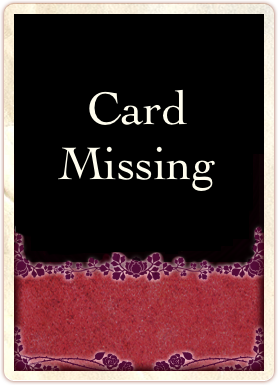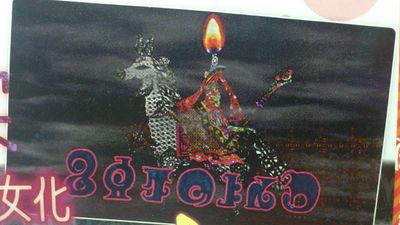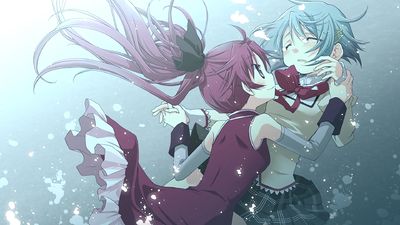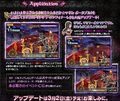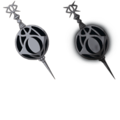Ophelia
Jump to navigation
Jump to search
Ophelia (OPHELIA) is the witch form of Kyoko Sakura, which is set to make an appearance in Puella Magi Madoka Magica Portable. Like the anime witches, she was designed by Gekidan Inu Curry.
武旦の魔女。その性質は自棄。霧の中を虚ろな足どりで永遠にさまよい続ける魔女。いつも傍らにいる馬が何だったのか魔女にはもう思い出せない。
|
The witch of wǔdàn. She has a self-abandoning nature. A witch who eternally wanders with hollow footsteps within the fog. She can no longer remember what the horse that always accompanies her was. | ||||||||||
Minions
The wǔdàn witch's minions, whose task is to march. They continually walk through the fog in an orderly fashion. The witch typically doesn't have any reason to approach these familiars. | |||||||||
Translations
From the March 2012 Dengeki PlayStation
Trivia
- The official website for Puella Magi Madoka Magica Portable refers to Ophelia as the witch of wǔdàn (武旦). A wǔdàn is a fierce female warrior in traditional Chinese opera.
- Ophelia will also appear in Mami's Heart Pounding Tiro Finale game.
- Musical scores resembling those in Oktavia's barrier can be seen floating in the background of Ophelia's barrier.
- Ophelia of Shakespeare's Hamlet was a young woman who had a famous and highly romanticized suicide. She went mad after the death of her father and being spurned by her love interest.
- Ophelia is riding a horned horse-like creature, which corresponds to the unicorn wind chime that represented Kyoko (opposite Sayaka's mermaid chime) in the BD version of episode 9.
- Ophelia can be thought of as a headless horseman.
- There are two German folk tales of a headless horseman:
- One is set near Dresden in eastern Germany. In this tale, a woman from Dresden goes out early one Sunday morning to gather acorns in a forest. At a place called "Lost Waters", she hears a hunting horn. When she hears it again, she turns around she sees a headless man in a long grey coat sitting on a grey horse.
- In another German tale, set in Brunswick, a headless horseman called "the wild huntsman" blows a horn which warns hunters not to ride the next day, because they will meet with an accident.
- In some German versions of the headless horseman, he seeks out the perpetrators of capital crimes. In others, he has a pack of black hounds with tongues of fire.
- There are two German folk tales of a headless horseman:
- Kyoko is known for being a hot-headed character.
- The name Ophelia is derived from the Greek οφελος (ophelos), meaning "help". This name was probably created by the 15th-century poet Jacopo Sannazaro for a character in his poem 'Arcadia'.[1]
- The word 'Arcadia' has a connotation with an Utopian vision of pastoralism and harmony with nature. This type of setting appears in many works of fiction.
- Commonly thought of as being in line with Utopian ideals, Arcadia differs from that tradition in that it is more often specifically regarded as unattainable. Furthermore, it is seen as a lost, Edenic form of life, contrasting to the progressive nature of Utopian desires.
- The word 'Arcadia' has a connotation with an Utopian vision of pastoralism and harmony with nature. This type of setting appears in many works of fiction.
- Ophelia is fought on a narrow bridge blocked off on either side by her barriers, somewhat reminiscent of the alley where Kyouko fought Sayaka in Episode 5.
Speculation & Observation
- Ophelia's familiars include geishas and goldfish.
- Fish have various symbolic meanings:
- Early Christians used a fish symbol to represent the Christian faith.
- In Buddhism, fish can represent abundance and fertility, or living beings who practice the dharma need have no fear to drown in the ocean of suffering, and can freely migrate (chose their rebirth) like fish in the water.
- Adaptability, change, and transformation in Greco-Roman, East Indian, and Norse mythology.
- Goldfish are associated with fortune and wealth. One of the eight auspicious signs of Buddhism is a pair of goldfish, representing the state of fearless suspension in a harmless ocean of samsara.
- Geishas were seen as a form of independence for females outside of the traditional wife and family role. Kyoko resorted to non-traditional methods and self-sacrifice to support her family.
- Fish have various symbolic meanings:
- Ophelia of Hamlet's main conflict was between obeying her father or her love interest. She had a fear of intimacy and eventually went mad under the pressure of her father's death and her lover's rejection of her. Kyoko lost her family and was spurned by Sayaka.
- The story of Ophelia's suicide by drowning is striking in a number of ways. First, her death seems to be passive: rather than straight-up committing suicide, as Gertrude (The Queen in Hamlet, who shares a name with the witch Gertrud) tells us, she accidentally falls in the water and then simply neglects to save herself from sinking. This seems to be a metaphor for the way Ophelia lives her life toward the end of the play – going with the flow, doing what her father tells her to do, rather making decisions for herself. Ophelia's "garments" "pull" her down, as if they had a mind of their own. Likewise, Kyoko followed wherever life lead her and was pulled down by her magical girl status.
- Ophelia is described as being "mermaid-like" with her "clothes spread wide." Even in death, Ophelia is figured as an erotic creature. Gertrude also suggests that Ophelia's drowning was natural when she describes Ophelia as being like a "native" creature in the water. Kyoko killed herself in an attempt to reach Sayaka, who took on the form of a mermaid as Oktavia, and whose transformation into a witch resonates with the features of water and the implied theme of drowning. Sayaka and Kyoko appear together underwater in the BD 5 artwork to the right.
- Ophelia's famous death scene is represented in various paintings, including one painting by Millais.
- Shakespeare readers have interpreted the Ophelia character to be linked to the idea of regret and unrequited love.
- In Norse Mythology, Valkyries rode into battle with spears —a weapon heavily associated with the god Odin.
- The spear was the symbol of the god Wodan and the most common weapon in Germanic armies; it was cheap to produce because it didn't need much iron and most types could be used for both stabbing or throwing. Most Germanic horsemen carried a shield and a spear though the footmen sometimes carried multiple spears; at the start of a battle these were thrown at the enemy and the last one was saved for close combat. According to Tacitus, the Germans were able to throw these spears immense distances. Some types of throwing spears were even equipped with a leather loop for the fingers so that they could be hurled even further.[2]
- The ceremonial use of candles is found in the practice of many religions. Light is everywhere the symbol of joy and of life-giving power, as darkness is of death and destruction. Fire, the most mysterious and impressive of the elements, the giver of light and of all the good things of life, is a thing sacred and adorable in primitive religions, and fire-worship still has its place in two at least of the great religions of the world.
- In Christianity the candle is commonly used in worship both for decoration and ambiance, and as a symbol that represents the light of God or, specifically, the light of Christ. The altar candle is often placed on the altar, usually in pairs.
- An Advent candle is a candle marked with the days of December up to Christmas Eve. It is typically used in a household rather than a church setting: each day in December the candle is burnt down a little more, to the mark for the day, to show the passing of the days leading up to Christmas. The custom of having an Advent candle in the house seems to have started in Germany, but it is now widespread in some other European countries such as the United Kingdom.
- It is suggested that the symbolism of the unicorn represents innocence. The fact that Ophelia is riding a horse, instead of a unicorn, has been speculated that the horse represents the loss of innocence and nobility. The image ingrains the idea that the unicorn has lost its horn along with its splendor and that it has become a regular equestrian animal.
- According to Chinese folklore, each animal is associated with certain personality traits, and those born in the year of the horse are intelligent, independent, and free-spirited.
- There is some reason to believe that Poseidon, like other water gods, was originally conceived under the form of a horse. In Greek art, Poseidon rides a chariot that was pulled by a hippocampus or by horses that could ride on the sea, and sailors sometimes drowned horses as a sacrifice to Poseidon to ensure a safe voyage.
- Homer describes Poseidon, who was god of horses (Poseidon Hippios), earthquakes, and the sea, drawn by "brazen-hoofed" horses over the sea's surface.
- Tacitus (Germania) mentions the use of white horses for divination by the Germanic tribes, where the behavior of a white stallion could decide peace or war.
- White horses (which are rarer than other colours of horse) have a special significance in the mythologies of cultures around the world. They are often associated with the sun chariot, with warrior-heroes, with fertility (in both mare and stallion manifestations), or with an end-of-time savior, but other interpretations exist as well. Both truly white horses and the more common grey horses, with completely white hair coats, were identified as "white" by various religious and cultural traditions.
- In the New Testament, the Four Horsemen of the Apocalypse include one seated on a white horse and one on a pale horse - the pale horse carried the rider, Death. However, the Greek word translated as pale is often interpreted as sickly green or ashen grey rather than white. Later in the Book of Revelation, Christ rides a white horse out of heaven at the head of the armies of heaven to judge and make war upon the earth.
- Saint George, the patron saint of horsemen among other things, rides a white horse in the tale of Saint George and the Dragon.
- It is speculated that perhaps the guilt that Kyoko carried with her due to her failure to protect her family, and later Sayaka, weighted too much on her causing Kyoko to turn into a witch.
- The homepage of the game declears her as 'Witch of warrior performer'(武旦の魔女).
- The imagery of Ophelia riding a horse is speculated to evoke the imagery of "Knight, Death and the Devil" (Ritter, Tod und Teufel), a large 1513 engraving, one of the three "master prints" of the German artist Albrecht Dürer.
- In the Japanese description in Witch illustrations, it says "The witch can't remember what the horse in her side is".
- If an unicorn is a symbol of purity and grace, then this may imply Kyoko lost both before she turned into the witch.
Gallery
Fanart
This section contains fanart images
Everything in the following fan gallery is created, or the comments accompanying them are created, for entertainment value and should not be confused with actual canon events of the Puella Magi franchise.- Ophelia witch card.jpg
- Ophelia form human fanart badass.jpg
- Ophelia fanart witch form.jpg
- Ophelia-art.jpg
- 25337862.jpg
- Ophelia Grin Badass.jpg
Even as a witch Kyoko remains badass
- 25323945.jpg
- Candeloro and Ophelia.jpg
- 25292387.jpg
- 25296777 p0.jpg
- 25296777 p2.jpg
- OPHELIA black white artwork.jpg
- Ophelia kyouko sayaka cartoon raw fanart.jpg
- Candeloro and ophelia fanart together.jpg
- Ophelia horse fanart witch human form.jpg
